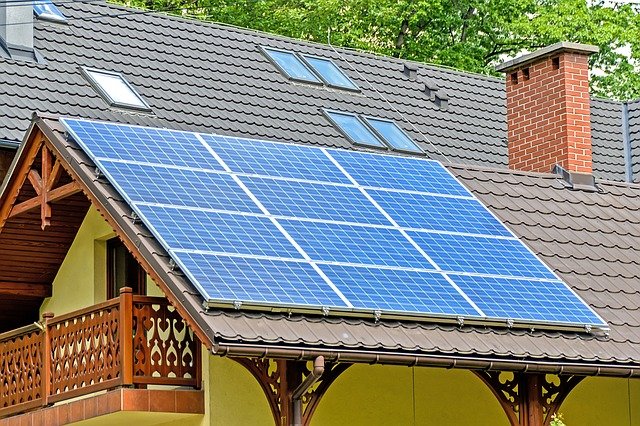Solar 3.0 Is Here - What's Next?
Solar 3.0 is Here
Welcome to the future of solar power – Solar 3.0! In this age of advanced technology and innovation, it's no surprise that even solar energy has radically transformed. Gone are the days when solar panels were limited to rooftops, soaking up the sun's rays to generate electricity. Solar 3.0 is here, ready to revolutionize, harnessing and utilizing renewable energy.
But what exactly is Solar 3.0? How does it differ from traditional solar power? And what benefits does it bring to our homes and businesses? Join us as we delve into the world of Solar 3.0, exploring its history, various technologies, working principles, and much more!
So sit back, relax, and let us shed some light on this exciting new chapter in solar energy, from solar panels Dallas, Texas to Solar 3.0!
Solar 3.0 in the Next Generation of Solar Power
Solar 3.0 is the next generation of solar power that pushes the boundaries of what we thought was possible. It represents a significant leap forward in efficiency, versatility, and overall performance. Unlike traditional solar energy systems, Solar 3.0 goes beyond just generating electricity; it aims to maximize the potential of renewable energy sources.
So, what sets Solar 3.0 apart? It embraces a wide range of innovative technologies that work harmoniously to capture sunlight more efficiently than ever. From advanced photovoltaic cells and concentrated solar power systems to flexible panels and integrated storage solutions – Solar 3.0 offers a diverse array of options tailored to meet specific needs.
Moreover, one key aspect of Solar 3.0 lies in its focus on integration with other intelligent technologies, such as IoT (Internet of Things) devices and artificial intelligence algorithms, enabling seamless communication between various components for optimized performance.
Solar 3.0 marks an evolution from simply harnessing solar energy towards leveraging its full potential through cutting-edge technology advancements and intelligent system design - making clean energy more accessible and sustainable for everyone.
The History of Solar Power
Solar power dates back thousands of years to ancient civilizations that used the sun's energy for various purposes. The earliest known use of solar power can be traced back to the 7th century BC when people in China and Greece used magnifying glasses to concentrate sunlight and create fire.
Fast forward to the 19th century, when scientists began experimenting with photovoltaic cells made from selenium. In 1839, French physicist Alexandre Edmond Becquerel discovered the photovoltaic effect - a phenomenon where certain materials produce an electric current when exposed to light.
Solar power continued to develop throughout the 20th century, with breakthroughs occurring in the 1950s. Bell Labs introduced silicon-based solar cells that were more efficient than previous designs. This led to increased research and development into improving solar technology.
In recent decades, advancements in manufacturing processes have brought down costs significantly. With improved efficiency and affordability, solar power has become an increasingly viable option for generating electricity on a large scale. We are witnessing a new solar energy era with Solar 3.0 technologies.
From humble beginnings as simple magnifying glasses harnessing sunlight's heat to sophisticated silicon-based panels converting sunlight into electricity efficiently, solar power has come a long way over centuries of innovation and discovery.
The Different Types of Solar 3.0 Technologies
Solar 3.0 technologies have revolutionized how we harness energy from the sun, offering advanced solutions beyond traditional solar power systems. These cutting-edge technologies pave the way for a more efficient and sustainable future.
One of the critical advancements in Solar 3.0 is Concentrated Solar Power (CSP). Unlike traditional photovoltaic panels that convert sunlight directly into electricity, CSP uses mirrors to concentrate sunlight onto a receiver, which converts it into thermal energy. This thermal energy can generate electricity or provide heat for industrial processes.
Another type of Solar 3.0 technology is Thin-Film Photovoltaics (TFPV). Instead of silicon-based cells like conventional solar panels, TFPV utilizes thin layers of semiconductor materials such as cadmium telluride or copper indium gallium selenide. These thin films can be deposited on various surfaces, allowing for flexible and lightweight solar modules.
Next up is Solar Paint – an innovative concept where specially formulated paints contain tiny particles that can absorb sunlight and convert it into usable electricity. Imagine being able to turn any surface into a potential solar generator!
Additionally, Organic Photovoltaics (OPV) employs organic compounds rather than inorganic semiconductors found in traditional PV cells. OPV offers benefits such as flexibility, transparency, and low-cost production methods.
We have Floating Solar Farms – an ingenious solution that addresses land scarcity issues by installing photovoltaic arrays on bodies of water such as reservoirs or ponds. This utilizes otherwise unused space and helps reduce evaporation rates while maximizing energy generation through natural cooling effects.
These different types of Solar 3.0 technologies demonstrate how innovation has propelled solar power toward new horizons beyond previously thought possible.
Do you know how Solar 3.0 Works?
Solar 3.0 is an advanced solar energy technology that harnesses the sun's power more efficiently and effectively. Unlike traditional solar panels, which directly convert sunlight into electricity, Solar 3.0 utilizes innovative techniques to optimize energy generation.
One key aspect of Solar 3.0 is the use of tracking systems. These systems allow solar panels to follow the movement of the sun throughout the day, maximizing their exposure to sunlight and increasing energy production. These panels can constantly adjust their position to capture sunlight from dawn to dusk.
Another feature of Solar 3.0 is its integration with energy storage solutions such as batteries or fuel cells. This allows excess energy generated during peak sunlight hours to be stored for later use when there is less sunshine or during nighttime hours.
Additionally, Solar 3.0 incorporates intelligent grid technology, enabling seamless communication between solar installations and utility companies' power grids. This integration facilitates better management and distribution of electricity produced by solar systems.
Furthermore, some versions of Solar 3.0 utilize advanced materials like perovskite in photovoltaic cells instead of traditional silicon-based ones, resulting in higher conversion efficiencies and lower costs.
Solar 3.0 represents a significant leap forward in renewable energy technology by utilizing advanced tracking systems, incorporating energy storage solutions, and integrating with intelligent grids to use solar power resources efficiently.
The Benefits of Solar 3.0
Solar 3.0 brings a host of benefits that make it an attractive option for homeowners and businesses alike. One of the key advantages is its increased efficiency compared to traditional solar energy systems. Thanks to technological advancements, Solar 3.0 can convert sunlight into electricity much faster, allowing for more excellent energy production.
Another benefit of Solar 3.0 is its versatility and scalability. Unlike older solar technologies requiring large rooftop installations or vast fields of panels, Solar 3.0 can be integrated into various surfaces such as windows, roofs, and clothing! This flexibility opens up new possibilities for harnessing solar power in urban areas with limited space.
Additionally, Solar 3.0 offers improved aesthetics compared to its predecessors. The sleek design and seamless integration options make it more visually appealing, making it an excellent choice for those concerned about maintaining the aesthetic appeal of their property.
Furthermore, Solar 3.0 contributes significantly to reducing carbon emissions and combating climate change by generating clean, renewable energy without any harmful byproducts or greenhouse gas emissions associated with fossil fuels.
One must recognize the financial benefits that come with adopting Solar 3.0 technology. With lower installation costs and potential incentives such as tax credits or net metering programs offered by many governments across the globe; investing in Solar 3.0 can lead to long-term savings on utility bills while increasing property value.
Solar 3.0 vs. Traditional Solar Energy
Traditional solar energy has been a game-changer for many years when it comes to harnessing the sun's power. However, as technology continues to advance at a rapid pace, a new era of solar energy is emerging - Solar 3.0.
One of the critical differences between Solar 3.0 and traditional solar energy lies in their efficiency levels. While conventional solar panels have an average efficiency rate of around 15-20%, Solar 3.0 technologies are pushing these limits further by achieving efficiencies upwards of 40%. This means that with Solar 3.0, you can generate more electricity using fewer panels and less space.
Another significant difference is the integration of storage systems into Solar 3.0 solutions. Traditional solar energy relies on grid connection or net metering to ensure continuous power supply during periods when sunlight is limited or non-existent (such as nighttime). In contrast, Solar 3.0 incorporates advanced battery storage technologies that allow excess energy produced during peak sunlight hours to be stored for later use.
Moreover, while traditional solar panels are typically rigid and heavy, limiting their applications to rooftops or large open spaces, Solar 3.0 introduces flexible and lightweight options such as thin-film photovoltaic modules that can be integrated into various surfaces like windows or even clothing.
Furthermore, one must recognize the advancements in smart grid integration brought forth by Solar 3. These cutting-edge systems enable seamless communication between individual solar installations and utility providers through real-time data exchange, optimizing overall system performance while ensuring efficient distribution and consumption of clean energy.
Solar technology has come a long way since its inception decades ago; however, there's no denying the emergence of Solar 3.0.
The Future of Solar 3.0
Solar 3.0 is an exciting advancement in solar power technology with immense potential for transforming the renewable energy landscape. By combining cutting-edge innovations with established solar technologies, Solar 3.0 represents the next phase in harnessing the sun's power.
Throughout history, solar power has evolved from humble beginnings to a reliable and sustainable energy source. From ancient civilizations using magnifying glasses to concentrate sunlight for fire-starting to the development of photovoltaic cells in the 19th century, we have come a long way in utilizing solar energy.
Solar 3.0 encompasses various advanced solar technologies poised to revolutionize how we generate and utilize solar power. These include high-efficiency photovoltaics (PV), concentrated solar power (CSP) systems, floating PV farms, integrated storage solutions, and even nanotechnology-based enhancements.
So how does Solar 3.0 work? The key lies in its ability to maximize efficiency and overcome some limitations of traditional solar energy systems. High-efficiency PV panels capture more sunlight and convert it into electricity at unprecedented rates. At the same time, CSP systems use mirrors or lenses to concentrate sunlight onto receivers filled with heat-transfer fluids or molten salts.
One significant advantage of Solar 3.0 is its potential for decentralized energy production. With smart grid integration and distributed generation capabilities, individual homes and businesses can become self-sufficient energy producers while feeding excess electricity back into the grid.
The benefits of Solar 3.0 are numerous and far-reaching. First and foremost is its contribution towards reducing greenhouse gas emissions by displacing fossil fuel consumption with clean, renewable energy sources like sunlight.


